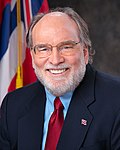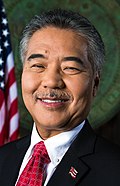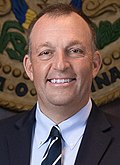List of governors of Hawaii
Governors of Hawaii From Wikipedia, the free encyclopedia
The governor of the State of Hawaii is the head of government of Hawaii,[1] and commander-in-chief of the state's military forces.[2] The governor has a duty to enforce state laws;[2] the power to either approve or veto bills passed by the Hawaii Legislature;[3] the power to convene the legislature;[4] and the power to grant pardons, except in cases of treason and impeachment.[2]
| Governor of Hawaii | |
|---|---|
| Ke Kiaʻaina o Hawaiʻi | |
 Gubernatorial standard | |
| Residence | Washington Place |
| Term length | Four years, renewable once |
| Precursor | Governor of Hawaii Territory |
| Inaugural holder | William F. Quinn |
| Formation | August 21, 1959 |
| Succession | Line of succession |
| Deputy | Lieutenant Governor of Hawaii |
| Website | governor |


Of the eight governors of the state, two have been elected to three terms, four have been elected to two terms, and one has been elected to one term. No state governor has yet resigned or died in office, nor did any territorial governor die in office. George Ariyoshi was the first Asian American to be governor of any U.S. state. The current governor is Democrat Josh Green, who took office on December 5, 2022.
The longest-serving governors are John A. Burns (1962–1974) and George Ariyoshi (1974–1986), both of whom served 12 years each.
List of governors
Summarize
Perspective
The Republic of Hawaii was annexed by the United States in 1898. It was organized into Hawaii Territory in 1900, and admitted as a state in 1959. The Republic had only one president, Sanford B. Dole, who later was the first territorial governor.
Hawaii Territory
Hawaii Territory was organized on June 14, 1900, remaining a territory for 59 years. Twelve people served as territorial governor, appointed by the president of the United States.
| No. | Governor | Term in office | Appointed by | |
|---|---|---|---|---|
| 1 |  |
Sanford B. Dole (1844–1926) [5] |
June 14, 1900[a] – November 23, 1903 (resigned)[b] |
William McKinley |
| 2 |  |
George R. Carter (1866–1933) [9] |
November 23, 1903[c] – August 15, 1907 (resigned)[d] |
Theodore Roosevelt |
| 3 |  |
Walter F. Frear (1863–1948) [13] |
August 15, 1907[e] – November 29, 1913 (successor appointed) |
Theodore Roosevelt |
| 4 |  |
Lucius E. Pinkham (1850–1922) [16] |
November 29, 1913[f] – June 22, 1918 (successor appointed) |
Woodrow Wilson |
| 5 |  |
Charles J. McCarthy (1861–1929) [19] |
June 22, 1918[g] – July 5, 1921 (successor appointed) |
Woodrow Wilson |
| 6 |  |
Wallace Rider Farrington (1871–1933) [22] |
July 5, 1921[h] – July 5, 1929 (successor appointed) |
Warren G. Harding |
| Calvin Coolidge | ||||
| 7 |  |
Lawrence M. Judd (1887–1968) [26] |
July 5, 1929[i] – March 1, 1934 (successor appointed) |
Herbert Hoover |
| 8 |  |
Joseph Poindexter (1869–1951) [29] |
March 1, 1934[j] – August 24, 1942 (successor appointed) |
Franklin D. Roosevelt |
| 9 |  |
Ingram Stainback[k] (1883–1961) [34] |
August 24, 1942[l] – April 30, 1951 (resigned)[m] |
Franklin D. Roosevelt |
| Harry S. Truman | ||||
| 10 |  |
Oren E. Long (1889–1965) [38] |
May 8, 1951[n] – February 28, 1953 (successor appointed) |
Harry S. Truman |
| 11 |  |
Samuel Wilder King (1886–1959) [41] |
February 28, 1953[o] – August 29, 1957 (resigned)[p] |
Dwight D. Eisenhower |
| 12 |  |
William F. Quinn (1919–2006) [45][46][47] |
September 2, 1957[q] – August 21, 1959 (elected state governor) |
Dwight D. Eisenhower |
State of Hawaii
Hawaii was admitted to the Union on August 21, 1959, consisting of Hawaii Territory minus Palmyra Atoll. Since then, there have been nine governors.
The governor is elected to a four-year term commencing on the first Monday in the December following the election. The lieutenant governor is elected for the same term and, since 1964, on the same ticket as the governor.[1][50] The 1978 constitutional convention established a term limit of two consecutive terms for both offices.[1] If the office of governor is vacant, the lieutenant governor becomes governor; if the governor is out of the state or unable to fulfill duties, the lieutenant governor acts as governor during such absence or disability.[51]
| No. | Governor | Term of office | Party | Election | Lt. Governor[r] | |||
|---|---|---|---|---|---|---|---|---|
| 1 |  |
William F. Quinn (1919–2006) [45][46][47] |
August 21, 1959[52] – December 3, 1962 (lost election) |
Republican[53] | 1959 | James Kealoha | ||
| 2 |  |
John A. Burns (1909–1975) [54][55] |
December 3, 1962[56] – December 2, 1974 (did not run)[54] |
Democratic[53] | 1962 | William S. Richardson (resigned April 13, 1966) | ||
| Andrew T.F. Ing | ||||||||
| 1966 | Thomas Gill | |||||||
| 1970 | George Ariyoshi | |||||||
| 3 |  |
George Ariyoshi (b. 1926) [57][58] |
December 2, 1974[59] – December 1, 1986 (term-limited)[s] |
Democratic[53] | 1974 | Nelson Doi | ||
| 1978 | Jean King | |||||||
| 1982 | John D. Waiheʻe III | |||||||
| 4 |  |
John D. Waiheʻe III (b. 1946) [61] |
December 1, 1986[62] – December 5, 1994 (term-limited)[s] |
Democratic[61] | 1986 | Ben Cayetano | ||
| 1990 | ||||||||
| 5 |  |
Ben Cayetano (b. 1939) [63] |
December 5, 1994[64] – December 2, 2002 (term-limited)[s] |
Democratic[63] | 1994 | Mazie Hirono | ||
| 1998 | ||||||||
| 6 |  |
Linda Lingle (b. 1953) [65] |
December 2, 2002[66] – December 6, 2010 (term-limited)[s] |
Republican[65] | 2002 | Duke Aiona | ||
| 2006 | ||||||||
| 7 |  |
Neil Abercrombie (b. 1938) [67] |
December 6, 2010[68] – December 1, 2014 (lost nomination)[69] |
Democratic[67] | 2010 | Brian Schatz (resigned December 26, 2012) | ||
| Vacant | ||||||||
| Shan Tsutsui (took office December 27, 2012) (resigned January 31, 2018) | ||||||||
| 8 |  |
David Ige (b. 1957) [70] |
December 1, 2014[71] – December 5, 2022 (term-limited)[s] |
Democratic[70] | 2014 | |||
| Vacant | ||||||||
| Doug Chin (took office February 2, 2018) | ||||||||
| 2018 | Josh Green | |||||||
| 9 |  |
Josh Green (b. 1970) [72] |
December 5, 2022[73] – Incumbent[t] |
Democratic[72] | 2022 | Sylvia Luke | ||
See also
Notes
- Dole resigned, having been confirmed to the United States District Court for Hawaii Territory.[5][8]
- Carter's term was to have ended November 23, 1907, but he had stated he did not wish to serve again, so his successor was appointed early.[12]
- Stainback had little power until October 24, 1944, as his predecessor had declared martial law on December 7, 1941, following the attack on Pearl Harbor, delegating executive authority to the military.[32] During the military rule, the territory was governed by Lieutenant Generals Walter Short, Delos Emmons, and Robert C. Richardson, Jr.[33]
- Stainback resigned due to poor health.[34]
- King resigned when denied a second term by President Eisenhower, to take effect when his successor took office.[44]
- Under the constitution as amended in 1978, governors cannot be elected to more than two consecutive terms.[60]
- Green's term will expire on December 7, 2026.
References
External links
Wikiwand - on
Seamless Wikipedia browsing. On steroids.

